June 9, 2025 —


Coast Guard senior leaders and representatives from the winning teams at the annual Capt. Niels P. Thomsen Innovation Awards ceremony that took place on April 30, 2025, at Coast Guard Headquarters in Washington, D.C. Pictured are, back row from left: Vice Adm. Peter Gautier, Chief Warrant Officer 2 Matthew Cole, Commodore John Krogmain, Lt. Hessamoddin Shafeian, Christopher Erskine, Michael Bacca, Lt. j.g. Cameron Craveiro, Brandon Blanchard, Cmdr. Matthew Eyler, Capt. Chad Brick and Master Chief Petty Officer of the Coast Guard Heath Jones. Front row from left: Tuyen Do, Teresa Yancoskie, Benjamin Newby, Capt. Tamara Wallen, Thea Petzling, Lt. Rebecca Edmonds and Lisa Schleder-Kirkpatrick. U.S. Coast Guard photo by Petty Officer 2nd Class Erik Villa Rodriguez.
Coast Guard leaders came together to celebrate the innovative spirit of the Coast Guard workforce during the Capt. Niels P. Thomsen Innovation Awards Ceremony held April 30 at Coast Guard Headquarters in Washington, D.C. The event included recognition of teams across six categories for their contributions in enhancing mission execution.
“As we talk today about our latest innovators, our current innovators, we’re inspired by the innovators of the past,” said Vice Adm. Peter Gautier, acting vice commandant of the Coast Guard. “It’s important to realize that the U.S. Coast Guard itself is an innovation … we lived in the eye of Alexander Hamilton, and the creation of a few small ships to collect tonnage-based tariffs … helped foster and grow our nascent country. And ever since then, from sail to steam to diesel, from the innovation of the use of helicopters for search and rescue all the way to the present when we talk about expanding the use of unmanned systems to perform our important missions … we have a long history of doing new and important things.”
“Today we recognize the Coast Guard innovators, who through their creativity, their talents and their collaborative efforts have demonstrated their commitment to creating a culture of continuous innovation,” said Lisa Schleder-Kirkpatrick, deputy assistant commandant of capabilities for the Coast Guard and co-chair of the Research, Development and Innovation Governance Council.
The annual awards recognize innovative efforts by the Coast Guard workforce to increase efficiency or productivity or provide other process improvements. Nominations were made through the service’s crowdsourcing platform; 51 projects covering six categories were considered for recognition in 2024.
This year’s winners:
Science or Technology
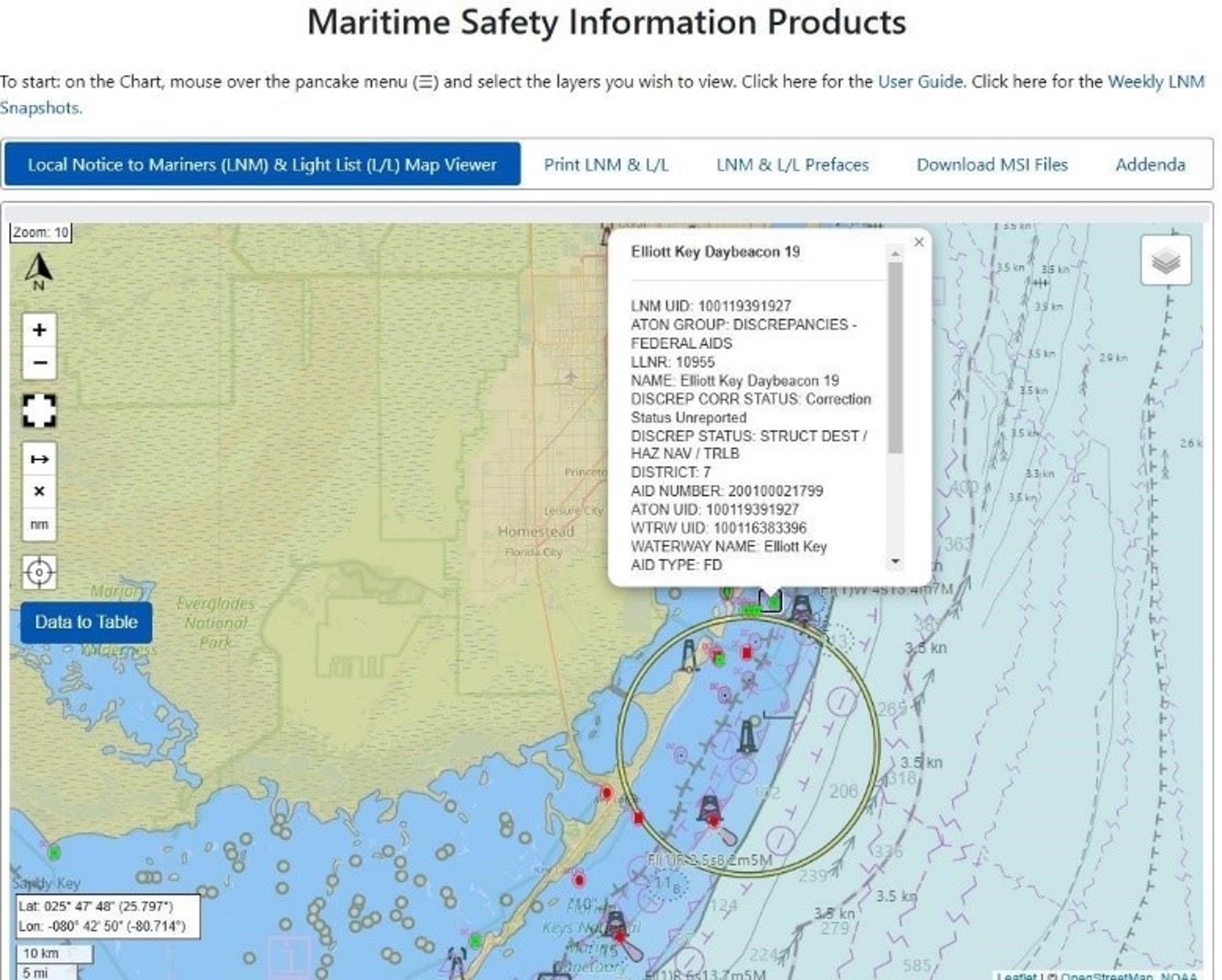
Advancing Maritime Safety: MSI App with Near-Real-Time GIS Display by the Maritime Safety Information Distribution Division at the Coast Guard Navigation Center
The Coast Guard Navigation Center in Alexandria, Virginia, provides maritime safety information to the public. The Maritime Safety Information (MSI) application they created is transforming how the Coast Guard delivers that critical marine safety information.
The data includes information such as the locations and conditions of aids to navigation and whether they have been displaced or damaged by storms; work on bridges; marine events; and hazardous navigation, according to Christopher Erskine, lead developer of the MSI app.
“Historically that data has been provided in a text-based format primarily on PDFs on the website,” he said. “We have turned (the static information) into a geospatial application that allows the public to see visually, on the website, the actual locations of these aids and these other areas out on the water,” Erskine said. “It’s very similar to Google or Apple maps that people are well used to using. They are able to come to our website and use our application and take all this information in visually and localize it.”
The new tool includes an interactive geographic information system (GIS) display, providing updated data to the Local Notices to Mariners site every 15 minutes and every hour for the Light List, a directory of navigational aids such as lighthouses, buoys and beacons managed by the Coast Guard. The intuitive GIS interface enhances situational awareness by allowing users to filter data by region, waterway or category while retaining the option to download PDFs for offline use. The app is also mobile-friendly and supports GIS-format downloads for integration with modern navigation systems, supporting efficient route planning.
“What it’s doing effectively for the Coast Guard is preventing accidents such as hazardous navigation mishaps and collisions,” said Michael Baca, chief of the Maritime Safety Information Distribution Division. “Additionally, it helps sectors with their common operating picture. They know where the problems are, and they can assign folks to go out and fix them.”
Team members: Michael J. Baca, Christopher Erskine, Eugene Diotalevi, Lt. j.g. Cameron Craveiro, Chief Warrant Officer Matthew Cole, Thea Petzling, Lora Blackburn, Brandon Blanchard, General Franklin, Scott Meyer, Terry Yancoskie, Matthew Will and Tuyen Do.
Operations or Readiness
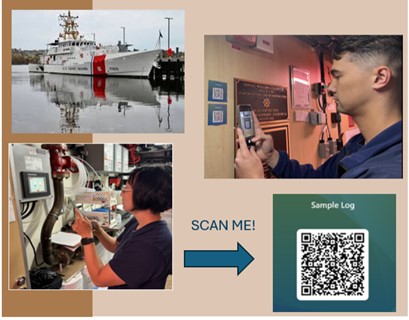
Automated Logs are a digital, QR-enabled logging system that streamlines data entry for watchstanders, ensuring accurate records and freeing up personnel for mission-critical operations.
Automated Logs: Bringing Logs to the 21st Century by The Auto-Mateys
Automated Logs introduces a QR-based system that enables personnel to log maintenance data instantly using mobile devices. By scanning a QR code at an equipment station, crew members can directly enter data into a structured Excel-based system, ensuring accuracy and reducing reporting delays.
“I had a vision of being able to do logs on your phone and not doing paper logs where then you have to put everything in the computer,” said Chief Petty Officer Emily Matter, who currently serves as engineer petty officer on Coast Guard Cutter William Chadwick. “But I didn’t have the right platform.”
This system requires no specialized software – it utilizes Microsoft Forms, Power Automate and Excel – making it highly adaptable across all Coast Guard units without costly implementation barriers. The process facilitates real-time trend analysis, allowing leaders to identify maintenance needs proactively, reducing unplanned downtime and extending equipment life cycles.
Automated Logs helps the Coast Guard improve operational efficiency and data accuracy and ensure compliance with maintenance schedules. It frees personnel for mission critical work by reducing labor hours spent on administrative tasks. “First, it saves a lot of time,” Matter said.
“And it also really improves data collection,” she said. Automated Logs enhances record retention and provides instant accessibility to maintenance history.
By integrating digital solutions into routine operations, Automated Logs establishes a scalable, fleet-wide model for modernizing Coast Guard maintenance tracking. “The beauty of the system is that everyone has access to it,” Matter said. “They just need to learn how to use it and then have the creativity to think about how they want to apply it.”
Team members: Chief Petty Officer Emily Matter and Petty Officer 1st Class Emmanuel Barber.
Administration, Training or Support
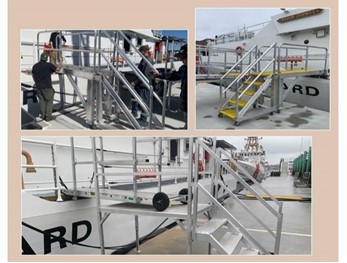

Four of the 11 innovations created by Base Boston: (top row) a lightweight, emergency-ready brow specifically designed for floating piers, facilitating safe and quick embarkation and reducing wear on deck equipment; (bottom row from left) a specialized tool that cuts inspection time for water pumps, allowing teams to meet maintenance standards faster and ensure engine reliability in high-stakes missions; streamlined battery removal tool that allows a single operator to handle 100-pound batteries while minimizing back strain, improving ergonomics and keeping maintenance teams available for other tasks; and a buoy tapper fabrication that addresses critical shortages and speeds buoy maintenance, ensuring district readiness by supplying essential parts at a fraction of the cost.
Naval Engineering Agile Operations and Fabrications by members of Base Boston Naval Engineering Department
Eleven innovations were deployed to make fabrication more efficient, improving quality, timelines and capability in naval engineering support at Base Boston. One example: the safety rail for the 49-foot buoy utility stern loading (BUSL) boat. “Our industrial facilities throughout the Coast Guard haul out these stern-loading boats for maintenance and repair,” said Cmdr. Matthew Eyler of Base Boston. “Our team developed a safety rail that replaces lines strung out across the stern that protects personnel from falls. This safety rail, through design, encourages compliance with safety procedures to embark and disembark the vessel.”
In addition to safety, many of these innovations result in Base Boston being able to return assets back to the fleet and to the customer faster, according to Eyler. An example is use of the waterjet cutting machine. By using the waterjet to make a BUSL chain stopper release mechanism (another of the division’s innovations), the time to produce the device is reduced from 8 hours to 45 minutes.
“Our junior officers and civilian skilled tradesmen at our industrial production facility, as well as weapons augmentation teams and maintenance augmentation teams, developed these ideas on their own,” Eyler said. “They’re working problems at the deck plate level; they’re seeing problems that I don’t see in management. They’re bringing them to our attention, and we’re providing them with the resources that empower them to solve these problems. I’m proud to lead a hundred-plus member group. And I’m proud to provide an environment through the Base Boston leadership that enables and empowers individuals to act on their ideas and think innovatively to provide solutions they see at their level.”
The other nine innovations the teams developed are:
- The MK38 weapon system toolkit aggregates all relevant tools in a single package, increasing jobsite efficiency and implementing point-of-use tool control.
- The Bay-class tugboat coolant pump tool facilitates backlash readings from outside the engine, saving 24 hours per inspection.
- The portable power panel uses existing infrastructure so portable welders can connect to shore tie plugs for pier side asset repairs.
- The fast response cutter brow and stand enable single-person rapid deployment and reduce deck coating wear with a universal coupling.
- The response boat-medium (RB-M) battery pulling tool facilitates overhead extraction and eliminates non-ergonomic, dangerous manual removal.
- RB-M alignment kits were re-engineered and distributed service-wide; the new kits include improvements from the originals and replace items that are no longer available.
- The BUSL mast cart combines transportation mode and paint, metal and electrical work platform.
- The buoy tapper fabrication reduces costs, saving more than $243,000 across 500 units.
- Boston Light wheel rollers were re-engineered from 1889 prints and modified for machining with modern tool fixtures to improve reliability.
In the era of information and technology innovations happening every day, “it is still essential and integral to create physical systems that enable the service to have the assets on the water and in the air to perform the Coast Guard’s missions,” Eyler said.
Team members: Petty Officer 1st Class Thomas Miles II, Petty Officer 2nd Class Angelo Russo, Petty Officer 1st Class Joseph Holt, Jeb McCandless, Michael Jacobs, Gordon Olson, Jake Sawyer, Gabriel Fragodt, Joshua Sherman, Magdaleno Medina, Christoper Benson, Chad Adams, Peter Murray, Brendan Henry, John Cullen, Dominick Tolson, Mike Derrico, Andre Lopez and Cmdr. Matthew Eyler.
Culture Change
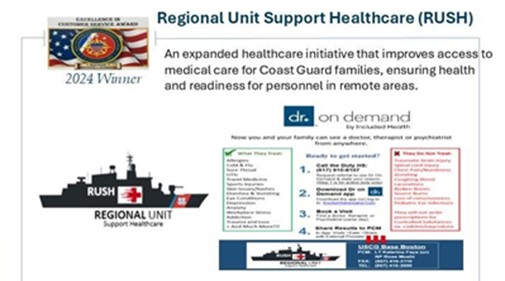
Total Guardian by District 1 Health, Safety, Safety and Work-Life Regional Practice
Total Guardian is an innovative suite of initiatives that expands beyond traditional medical readiness to address mental health, administrative, financial and professional readiness as well as dependent services. This holistic approach enhances support systems, mitigates challenges from primary care shortages and geographic distribution and increases overall resiliency.
Base Boston led the expansion of the Tailored Readiness Availability Mobile Unit (TRAMU) into the TRAMU Personal Readiness Operation (PRO), which provides direct care support, bridges healthcare gaps and assists dependents with billing issues. Notable impacts include a 33% increase in medical readiness across Coast Guard District 1, successful resolution of 62 acute mental health cases and the recovery of 19% of a member’s annual base pay in billing errors.
Additionally, a TRICARE-approved telehealth platform piloted at Base Boston provided additional capacity to address acute care needs and made more than 20 hours available for in-person clinic visits over the first three months of use. A first-of-its- kind TRAMU PRO event for Reserve personnel aims to reduce travel burdens and improve readiness by 35%.
By recognizing the whole person, Total Guardian delivers scalable, repeatable solutions that enhances Coast Guard readiness and quality of life.
“Total Guardian is a collaboration with the district, the base, the sector and all our units to work on the overall health of our personnel,” said Capt. Chad Brick, Base Boston commanding officer. “When you’re talking about the readiness of our personnel, we’re talking about the blue suiters themselves, as well as their families. We’re looking at all different aspects of health, whether it’s their physical health, their mental health or even their financial health in some ways.
“We’ve expanded in several different ways,” Brick continued. “Through TRAMU, we actually send personnel out to the different healthcare deserts and treat people on scene. There’s another part where we’re doing the technical side of healthcare delivery with telehealth, doctors on demand and some other programs.”
“We’re also talking to the families who are out there, so spouses will understand exactly the whole complex medical web,” Brick said. “And it was really interesting to see how much better we perform when you take care of not only the (service members) but also the families.”
Team members: Lt. Jamie Lane, Lt. Cmdr. Marvin Pena, Lt. Cmdr. Katerina Faya, Lt. Amanda Benson, Capt. Timothy Pappalardo, Heather Johnson, Chief Warrant Officer 2 Matthew Reines, Petty Officer 1st Class Michael Miozzi, Petty Officer 1st Class Luke Deckert, Petty Officer 2nd Class George Littleton, Chief Petty Officer Leah Halford, Petty Officer 1st Class Christine Ngo, Petty Officer 3rd Class Jake Prusha, Capt. Chad Brick, Cmdr. Paul Alexander and Master Chief Petty Officer Sean Fullwood.
Auxiliary Achievement
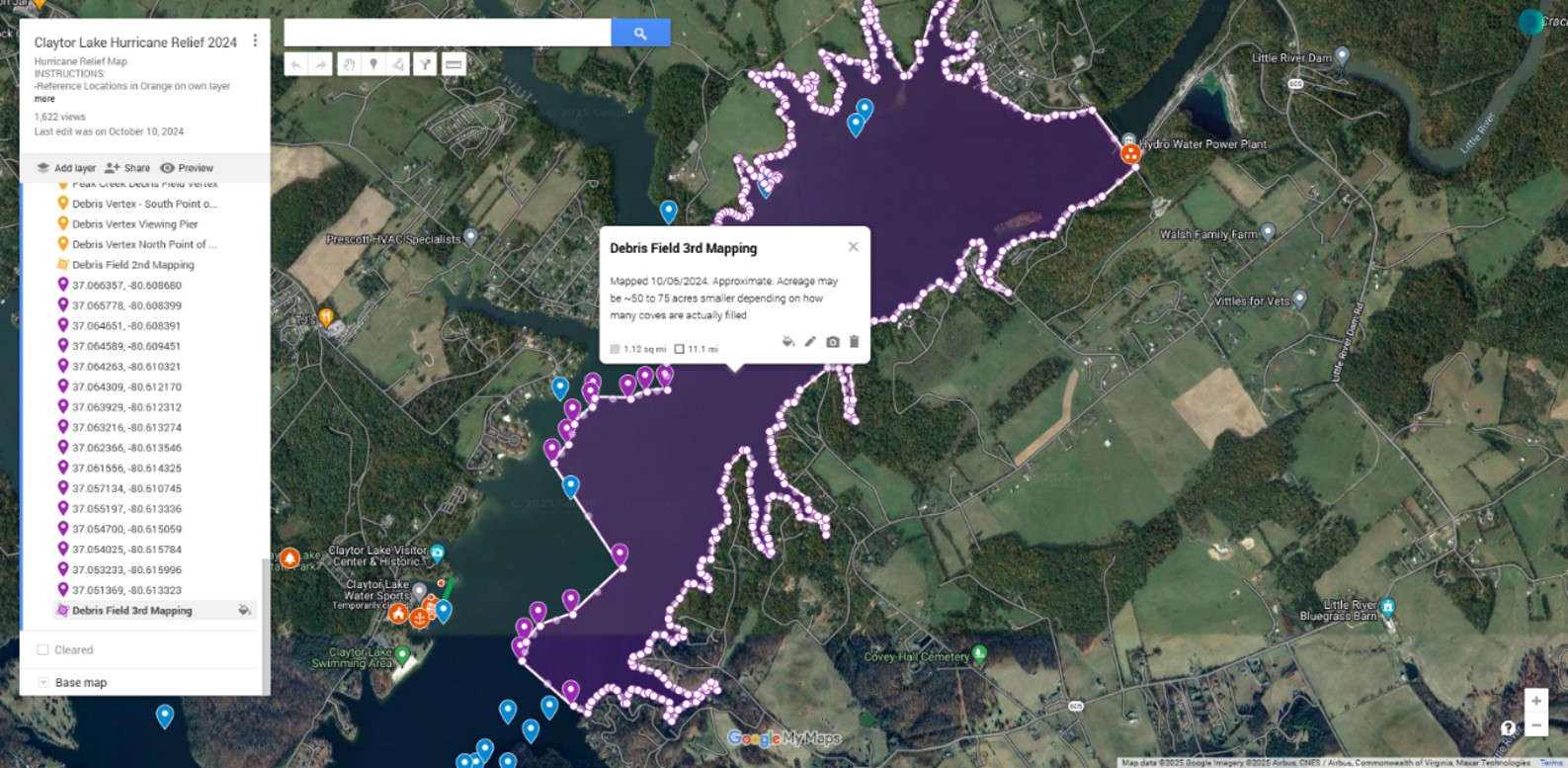
Cloud-Based Debris Field and Hazard Mapping Methods Using GPS data by New River Valley Flotilla
The New River Valley Flotilla, which provides Coast Guard Auxiliary services across Southwestern Virginia, pioneered a cloud-based debris mapping technique using GPS tracking during the response to Hurricane Helene, a category 4 hurricane that claimed 230 lives throughout the South. This innovation enabled rapid debris field measurement, hazard identification and real-time data sharing among interagency partners. The scalable methodology improved disaster response coordination and efficiency, providing a model for future Coast Guard operations.
“The product allows for very rapid and accurate measurements of debris fields and allows the Coast Guard to share that cost-free with other agencies using existing programs. It can also be utilized for other mapping over large areas, potentially oil spills, anything that covers a wider area that would otherwise be hard to measure,” said Benjamin Newby, flotilla staff officer for communication services.
“It started when we were out on our local waterway responding to the aftermath of Hurricane Helene. We were seeing all the destruction that had been wrought. Some of the local reporting was claiming that there were 20 acres of debris. We could see, plain as day, that there were far more than 20 acres. One of my shipmates came to me and asked if there was some way that we could go on Google Maps or something to show them that it was a lot more than 20 acres. From there I started rolling and built this program and we eventually mapped over 1,500 acres.” The flotilla was able to share those maps with other local agencies including the local rangers and other first responders as well as the Federal Emergency Management Agency, the Environmental Protection Agency and the Marine Corps of Engineers. “It really turned into something useful for everybody,” he said.
Team members: Benjamin Newby, Cameron Alemand and Steve Holcomb.
Cmdr. Joel Magnussen Innovation Award for Management
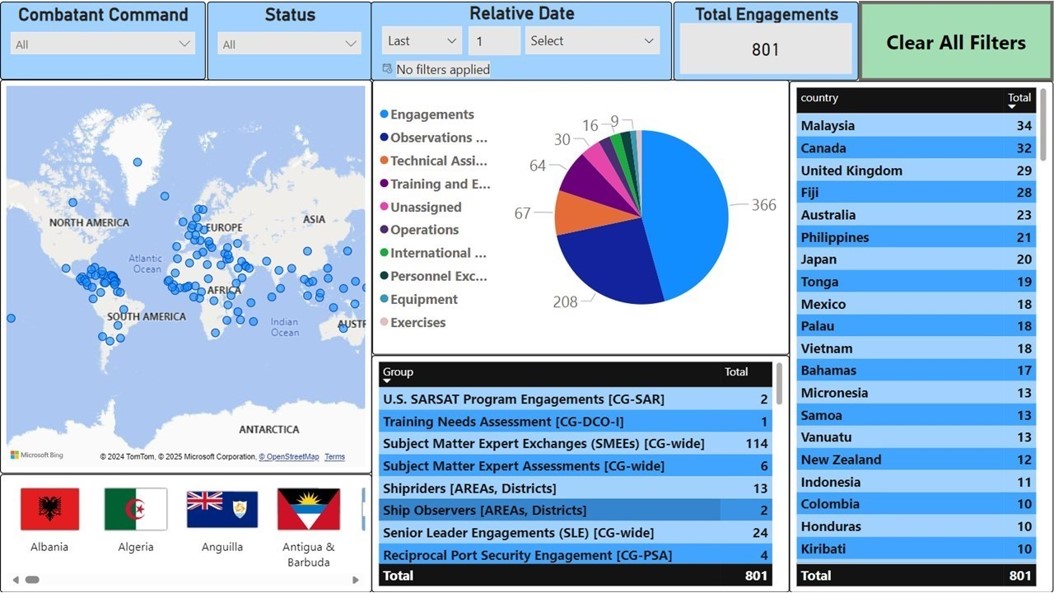
Global Dashboard for International Activities and Engagement by the Coast Guard Office of International Affairs and Foreign Policy Global Dashboard Initiation Team
The team from the Coast Guard Office of International Affairs and Foreign Policy (DCO-I) identified and acted upon a rare opportunity to significantly shape the Coast Guard’s approach to executing a cohesive global strategy while demonstrating a keen ability to leverage technology and knowledge management systems. After identifying a service-wide need and desire for improved mission alignment, prioritization and tracking, the DCO-I Global Dashboard Initiation Team came together to construct a tool that integrates existing international affairs data with established regional and country-specific objectives.
“The Coast Guard has these incredible missions that we’ve always performed well domestically, and right now we’re expanding our footprint internationally in so many different directions and so many different mission sets, it can often feel hard to keep track,” said Lt. Zachary Thomas of DCO-I. “This dashboard provides a centralized place for anyone in the Coast Guard to get that information and have a good overview as to what we’re doing in any specific country.”
Stakeholders can now access, with just a few clicks, a data-driven analysis of the Coast Guard’s international efforts. Users can set parameters to view international activities and engagements by date, status, location, category of engagement and mission objective with access to associated documents and reports. The user-friendly interface provides international affairs stakeholders with a centralized system for documenting, analyzing, synchronizing, briefing and strategizing Coast Guard international affairs objective and engagements.
Team members: Capt. Tamara Wallen, Lt. Zachary Thomas, Lt. Hessamoddin Shafeian and Lt. Rebecca Edmonds.
Related video highlighting each of the awardees:
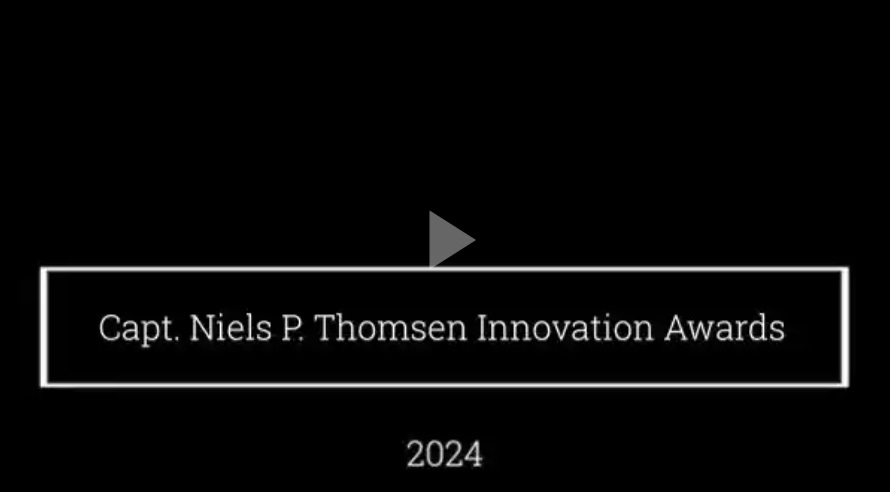
Video: Capt. Niels P. Thomsen Innovation Awards 2024
For more information on the Capt. Niels P. Thomsen Innovation Awards
For more information on Coast Guard R&D: Research, Development, Test and Evaluation Program page and Innovation Program page